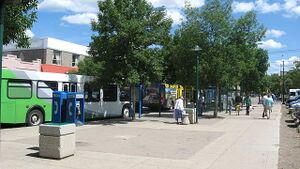
- Solar power's popularity is on the rise in Saskatchewan, Nov 24, 2017...[1]
Sustainability initiatives[edit | edit source]
Climate action[edit | edit source]
wikipedia:Climate change in Saskatchewan#Government plans
Food activism[edit | edit source]
Sustainable transport activism[edit | edit source]
wikipedia:Transportation in Saskatchewan#Hiking trails in Saskatchewan
About Saskatchewan[edit | edit source]
Saskatchewan ( sə-SKATCH-(ə-)wən, Canadian French: [saskatʃəˈwan]) is a province in Western Canada. It is bordered on the west by Alberta, on the north by the Northwest Territories, on the east by Manitoba, to the northeast by Nunavut, and to the south by the United States (Montana and North Dakota). Saskatchewan and Alberta are the only landlocked provinces of Canada. In 2024, Saskatchewan's population was estimated at 1,239,865. Nearly 10% of Saskatchewan's total area of 651,900 km2 (251,700 sq mi) is fresh water, mostly rivers, reservoirs, and lakes.
Residents live primarily in the southern prairie half of the province, while the northern half is mostly forested and sparsely populated. Roughly half live in the province's largest city, Saskatoon, or the provincial capital, Regina. Other notable cities include Prince Albert, Moose Jaw, Yorkton, Swift Current, North Battleford, Estevan, Weyburn, Melfort, and the border city of Lloydminster. English is the primary language of the province, with 82.4% of Saskatchewanians speaking English as their first language.
References